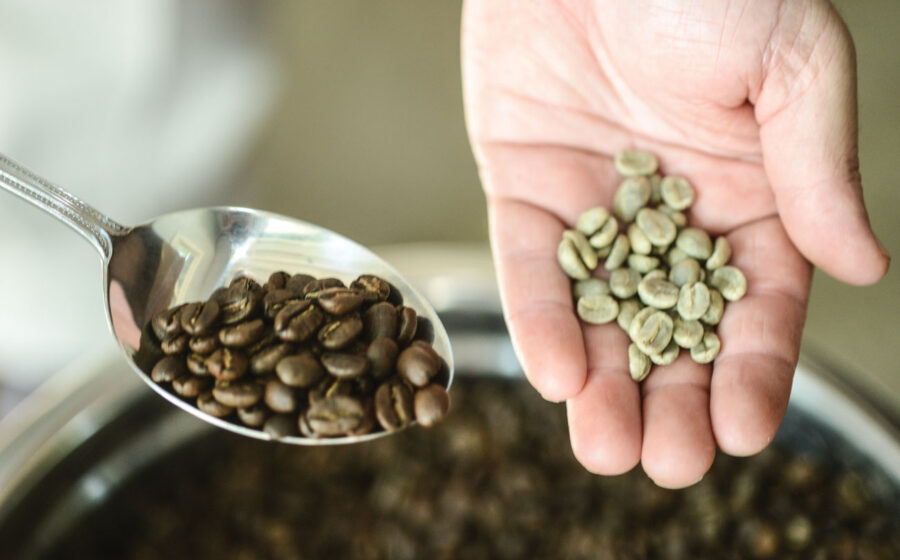[G]rowing up on a Mennonite farm near Harrisonburg, Virginia, grabbing a cup of coffee on the way out to the barn was a normal part of Weston Showalter’s daily life. So was the pot of coffee his parents brewed every evening at bedtime, and the coffee they served at mealtimes, especially when guests were around. But it wasn’t his love of coffee or even an entrepreneurial spirit that started Weston roasting his own coffee beans. It was his inquisitive mind, which as a youngster had kept him in the woods for hours, studying plants and bringing nature into his bedroom until it “looked like a museum,” he says. As an adult, it was this same inquisitiveness, and a fascination with cultures, that got Weston interested in roasting coffees from around the world.
It began when a friend gave Weston a hot-air popcorn popper while he and his wife Heidi Showalter, who grew up Amish, were serving as missionaries in Belize. As they traveled throughout Central America, they met people who could provide them green coffee, giving Weston the perfect opportunity to combine the hot-air popcorn popper with his love of learning. At first Weston roasted the beans only for himself, but eventually people at the mission church asked for coffee, and he roasted some beans to sell. “I roasted it all in this little hot air popcorn popper,” he said. “You could roast like a third of a cup at a time.”
Weston didn’t stop with roasting coffee. He met an elderly Belizean man who had grown coffee in his younger years, although Belize is not ideal for farming coffee because of its low elevation. Now years later the man was bedfast, and his coffee trees were overgrown with weeds and vines. With the man’s permission, Weston chopped away the brush and picked the coffee cherries as they ripened.
Then the Showalters had the tedious job of processing the berries by hand. The work ethic and perseverance of their Amish and Mennonite backgrounds kicked in. After picking several grocery bags of cherries, they pulped the beans, soaked them overnight, and then laid them out in the sun to dry. While Weston taught school in a nearby village during the day, Heidi watched the coffee beans. “Rain showers would come up real quick, and she would run out and bring the beans in so they wouldn’t get wet,” Weston says. After the beans dried, the parchment had to be peeled off. Without equipment to process them, they removed the parchment one bean at a time. In the end, the Showalters ended up with less than a quart of coffee beans, but the “whole experience of how coffee is processed is just really, really unique, and I’m glad I got to experience that,” Weston says.
As their term of missionary service in Belize neared an end, the couple talked about roasting and selling coffee once they returned to the United States. Early 2014 found them settling into their new home in Baltic, Ohio, near the area where Heidi grew up. The area is home to the world’s largest Amish settlement. Although Weston took a full-time job as a public relations specialist at a nearby humanitarian organization, the couple soon revisited the idea of roasting coffee beans on the side.
After doing research, Showalter found that a commercial coffee roaster would be far out of their price range. Instead he found a kit that modifies a gas grill and turns it into a coffee roaster using a rotisserie cage. “It works really, really well and has helped keep the startup costs way down,” Weston says. The outfit can roast about five pounds of coffee at a time, but already Showalter wishes he could do more. Barely a year into the business they called Baltic Coffee Company, the Showalters are roasting and packaging about as much coffee as they can keep up with. Weston spends most of his Saturdays in his detached garage roasting beans and then packaging them in the basement. “One of the biggest things I try to push is that the coffee is fresh,” he says. “I sell it within two weeks of roasting, or at least that’s the goal. I try to roast just enough that my inventory keeps rolling.”

In the tight-knit community where the Showalters live, people discover the coffee largely by word of mouth. A yard sign at the end of their driveway along a winding, state road also invites people in for freshly roasted coffee. “People see the sign and are curious enough to stop in to buy coffee,” Weston says. “It’s been a fun way to get to know people in the neighborhood.” Weston also sends weekly e-mail blasts advertising his coffee to his co-workers, family, and friends. While the vast majority of Baltic Coffee Company’s customers are Amish and Mennonites, some are English, the Amish term for anyone outside of the faith. “There are a lot of differences between us and mainstream America,” Weston says. “But that’s one common thing—we drink coffee, majorly.”
“Coffee is extremely important in the community,” says one Amish customer who prefers to remain anonymous, true to the Amish values of modesty and privacy. “It’s a big social thing. You discuss things over a cup of coffee. If nothing else, you talk about the coffee.” It’s not unusual to see Amish and Mennonites carrying Styrofoam cups of coffee at local auction barns or gracing the area’s coffee shops. Since the Amish do not use electricity in their homes, most often they brew their coffee with a french press or a pour-over. This Amish man, a farmer in the area, was happy to find someone local who roasts coffee in small batches and experiments with various roasts. “The big companies blend all kinds of beans and roast them to death, and it all tastes the same all the time,” he says. “Weston rarely blends beans and uses no additives, ever. I like the pure taste of the coffee.”
Although most Amish and Mennonites still go home from the store with the major coffee brands, because it’s more economical, this farmer hopes more of them will see the value of buying from small roasters. “Most of my friends like coffee but aren’t used to fresh ground beans,” he says. “Everyone is enjoying the coffee when they come to our house.”
Weston admits there’s a “real learning curve” to roasting coffee, and he’s ended up with batches that weren’t worth selling. “Thirty seconds in a roast can make the difference between a good batch and a bad batch. You have to be noticing smells and sounds.” Logging every batch has helped him establish a level of consistency. “Every coffee acts differently, and if you don’t record what you did, you can’t get to know that coffee as well.”
Roasting has come mostly by trial and error, but Weston also credits a roaster in Columbus for giving him an early-on wealth of information and boost of confidence. The day he stopped by Stauf’s Coffee Roasters, in operation since 1988, owner Tom Griesemer was roasting coffee and “unloaded information on me,” Weston says. “He’s all about helping roasters get started. He doesn’t make you feel like it’s a science.”
When Griesemer told Weston the equipment he uses is probably the best he could have gotten for the price range he was looking at, it was the reassurance he needed to keep going. Griesemer also gave Weston samples of coffee similar to what he roasts at home so he can compare the two. “It encouraged me to help other people [who are starting out] too,” Weston says.
He wants to give his customers a taste from around the world, using beans from Africa, Asia, Central America, and South America, and right now a Colombian and a Yirgacheffe are his customers’ favorites. He keeps most of his coffees at a medium roast, though like many drinkers in the Midwest, many of his customers want dark roasts. The project is still, in part, for his own drinking pleasure, and he can’t help but try several pounds of a new coffee every time he orders, just because “it’s fun to always be trying something new.”
Weston has no plans to become a big roaster, but true to his Mennonite heritage he wants his home business to be a place where he can one day work together with his family and instill a robust work ethic into his children. “I’ll probably never have a big place with animals and stuff for my children to take care of and do, so this is something I envision the girls could do once they get older.” He hopes his two daughters, Nadia who is five and Anya who is three, will one day help with packaging, assembling coffee gift baskets, or channeling their interests into some other part of the business.
Weston also dreams of buying coffee more directly from coffee farmers and has the contacts to make it happen. One Mennonite coffee importer in Honduras helps coffee farmers raise the quality of their coffee to get consistently higher prices for their beans. A more direct connection would ensure that the farmers he buys from are making a fair wage, something important to Weston. It was also something he made sure of when he chose Theta Ridge Coffee as his source for green beans.
Some of Weston’s coffee is going to his hometown back in Virginia. A steady supporter of her son’s new venture, his mother has ordered his coffee from the beginning of Baltic Coffee Company and introduced it in her community. “Now those people are calling me to order,” Weston says.
Although coffee roasting is a rather unusual business in the Amish and Mennonite community, there is a growing interest. “Specialty coffee is on the rise everywhere, and Amish and Mennonites do like quality things,” Weston says. He’s says he’s glad to be a part of providing good coffee to his community.
—Rachel Mast is a freelance writer in Ohio’s Amish country.


















